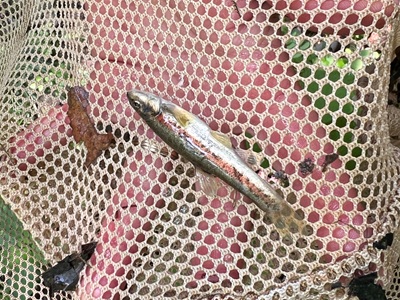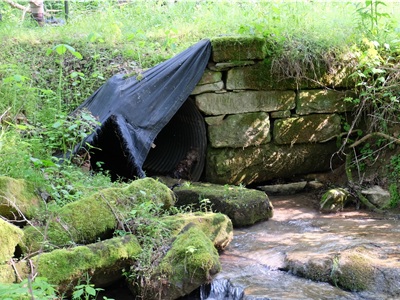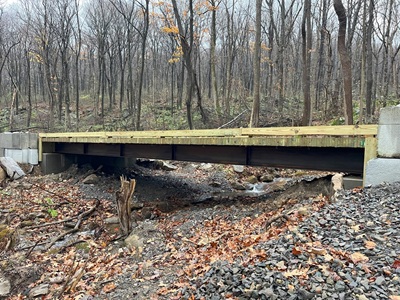WPC Removes Barriers to Help Species Move Freely
Have you ever fished or hiked along a stream and come upon a culvert pipe? Unless you’ve seen one from a fish’s eye level, you might not realize what an obstacle a pipe can present to a fish trying to swim upstream. To a fish, a pipe is akin to a brick wall in the path of a marathon runner.
 Take for example the eastern blacknose dace (shown here), a tiny fish native to Pennsylvania that lives in shallow, gently flowing streams. It swims upstream through the riffles in search of food and to mate.
Take for example the eastern blacknose dace (shown here), a tiny fish native to Pennsylvania that lives in shallow, gently flowing streams. It swims upstream through the riffles in search of food and to mate.
A dace that encounters a torrent of water from a three-foot diameter culvert pipe will struggle. Not only that, but trapped debris in the pipe can create waterfalls that no fish of that size, three inches or less, could ever jump. Upstream, on the other side of the pipe, a prime spawning area beckons. But the dace can’t get there.
Culvert pipes can spell disaster for populations of aquatic organisms such as black dace and other small fish native to Pennsylvania, as well as other species reliant on streams for passage, by creating barriers to their passage.
The Western Pennsylvania Conservancy’s watershed conservation team removes such barriers to aquatic organism passage, such as dams and culvert pipes, creating natural pathways to allow species to move freely. Pictured here is a culvert pipe on a stream in PA State Game Lands #245 near Claysville, Washington County.
“A culvert pipe is doing the same thing to the creek that you do when you place your thumb on the end of a garden hose to make a stronger stream of water,” explains Alysha Trexler, WPC watershed projects manager. “The speed of the water in the pipe is too fast for smaller native fish to swim up, so it essentially becomes a barrier. They can’t get upstream against the stronger velocity of the water.”
Some fish need to swim upstream to spawn, or reproduce, and have enough space for a population to live and eat, Alysha explains. Some prefer gravel flats, sandy openings or rock piles, with areas of less sedimentation that can smother eggs or entrap young. “When you disconnect a stream,” she says, “you’re disconnecting the ability of some species to reproduce. Populations can dwindle or disappear.”
In fact, some culverts form such extreme barriers that a stream can have no fish upstream, Alysha continues. “You have several miles of stream not being utilized by the native fish because of that barrier.”
Some terrestrial, or land, animals benefit from the removal of culvert pipes, too. “Salamanders and some turtles can’t necessarily go up and over a culvert pipe,” she says. “As amphibians, they breathe through their skin and need the moisture of the stream. They dehydrate trying to cross over a pipe. It’s the same problem with dirt and gravel roads in a forest…you wouldn’t think it’s that big to cross, but to them it’s essentially a desert.”
 After the pipe is removed, the water flows at a normal pace. Fish such as the tiny blacknose dace can swim freely upstream to live, eat and mate, and small terrestrial animals have room to walk along the edge of the stream. A timber deck bridge such as the one shown here allows water to flow under the bridge, providing safe passage for vehicles on the road and aquatic organisms in the stream.
After the pipe is removed, the water flows at a normal pace. Fish such as the tiny blacknose dace can swim freely upstream to live, eat and mate, and small terrestrial animals have room to walk along the edge of the stream. A timber deck bridge such as the one shown here allows water to flow under the bridge, providing safe passage for vehicles on the road and aquatic organisms in the stream.
Often, the watershed team surveys fish populations and tags fish before removing the barrier. That way, “After a culvert pipe is removed, we’ll be able to see how many of those fish go upstream. We’ll see if the population increases,” Alysha explains. “The science tells the story.”
